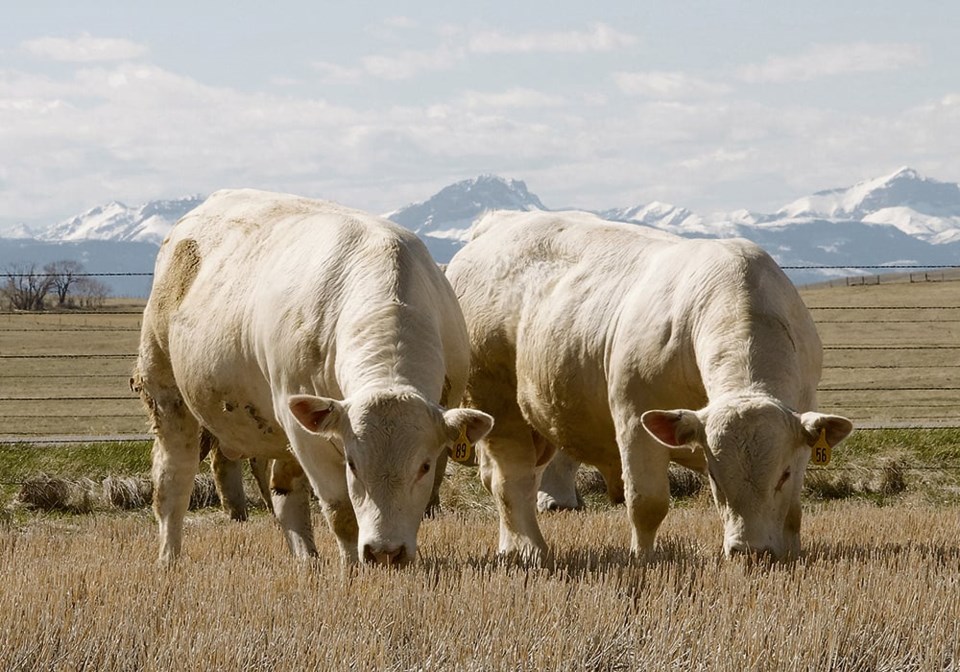WESTERN PRODUCER — Bulls should be separated from the cow herd after breeding season so they can regain body condition and then be kept in shape over winter in readiness for their next duties.
Dr. Robert Larson, professor in production medicine at Kansas State University, says it’s crucial to maintain adequate bull body condition.
“As we go into winter, bulls may be on stored forage, so they must be fed enough of it. The needs are different for a young bull that is still growing versus an older bull that just needs to maintain weight. If the forage quality is low, however, the older bull may still need a supplement,” he says.
Younger bulls should be kept in a separate group so they don’t have to compete with older ones that are generally more dominant. If young bulls are over-conditioned, they should be managed to slowly lose extra fat and then maintain body weight.
“Gradually reduce the concentrate portion of their diet. You want a diet that enables them to grow and maintain good body condition without being fat,” says Larson.
“The amount and type of feed for all bulls may need to be adjusted, depending on weather. Cold temperatures will increase their energy needs.”
Producers may also need to provide bedding for bulls to lower the risk of scrotal frostbite. If they are in confined areas, provide a manmade windbreak. If they are out on pasture with no natural windbreaks, there are various designs for adequate wind protection.
Multiple bulls may need to be sorted into compatible groups to prevent fighting and injuries. Existing fences can be made more secure with an electric wire, which usually keeps bulls from trying to get through a fence to fight or to be with cows.
Larson says the main thing is to pay attention to the bulls and not ignore them in winter.
“It boils down to good nutrition, good environment, parasite control, etc. so they will be ready for the next breeding season. They should receive the same vaccinations that cows of the same age receive.
“Young bulls should be vaccinated like replacement heifers and the mature bulls vaccinated like your mature cows. The exception would be that bulls must not be vaccinated for brucellosis,” says Larson.
Brett DeBruycker of DeBruycker Charolais in Dutton, Montana, says grouping first-year bulls separately from other sires after the breeding season makes it easier to give the youngsters better feed and care.
“On our operation we can’t always do that because of space constraints, but we try to separate them if we can. Many commercial producers have the same problem. If they only have one place for bulls, they’re stuck with that. Still, it is important to get the young bulls into better condition after their first breeding season, to give them more longevity in their service life.
“It varies from year to year but we try to have a large enough area, if we need to have all the bulls together, with good fall pasture so the young bulls don’t have to compete with the older ones.
“In the harshest part of the winter we generally have them in a smaller area, but still big enough to give them room to stay away from one another and have adequate exercise,” DeBruycker says.
Fencing can be an issue with bulls.
“We try to keep a good electric fence around them, but sometimes they go through a fence. We run our herd bull battery and our cows just like a commercial operation would. They have to rough it sometimes. They are not pampered or babied, but we do take care of them in a positive manner,” he says.
“If we have to use a small area, due to pasture concerns or numbers, I sort the young bulls into their own group. If necessary, depending on the situation, we put some lick tubs out for the young bulls. If they are in tough shape, a person could also feed cake for a month or two and pick them up a bit.”
Bulls are a big investment so it pays to keep them functional for as long as possible.
“You service your tractors, swathers and balers, and you need to treat your bull battery the same way,” says DeBruycker.
“They are your new genetics. They will be making your calf crop for the next several years, and hopefully keeping your ranch profitable. You want to take good care of those bulls.
“We make sure they are in a pasture with trees or windbreaks. We are also liberal with the straw we put out for bedding. When feeding hay, I spread it out in a longer line. If you simply dump it in a few spots, the older bulls pick on the younger ones.”
Timely deworming and vaccinations are also necessary, he adds.
All cattle are vulnerable to foot rot, but bulls seem more prone to this problem because of their additional weight and stress on their feet, plus the wear of travelling and fighting. If footing is wet or abrasive and rocky, nicks and scrapes can open the way for infection.
“Regarding other vaccinations, we make sure the bulls are vaccinated as well as possible when they are young. We vaccinate against just about everything,” DeBruycker says.
“Then we find they stay healthy later in life, with strong immunities. We believe in science and technology, and the value of vaccination, especially when these animals are young.”

